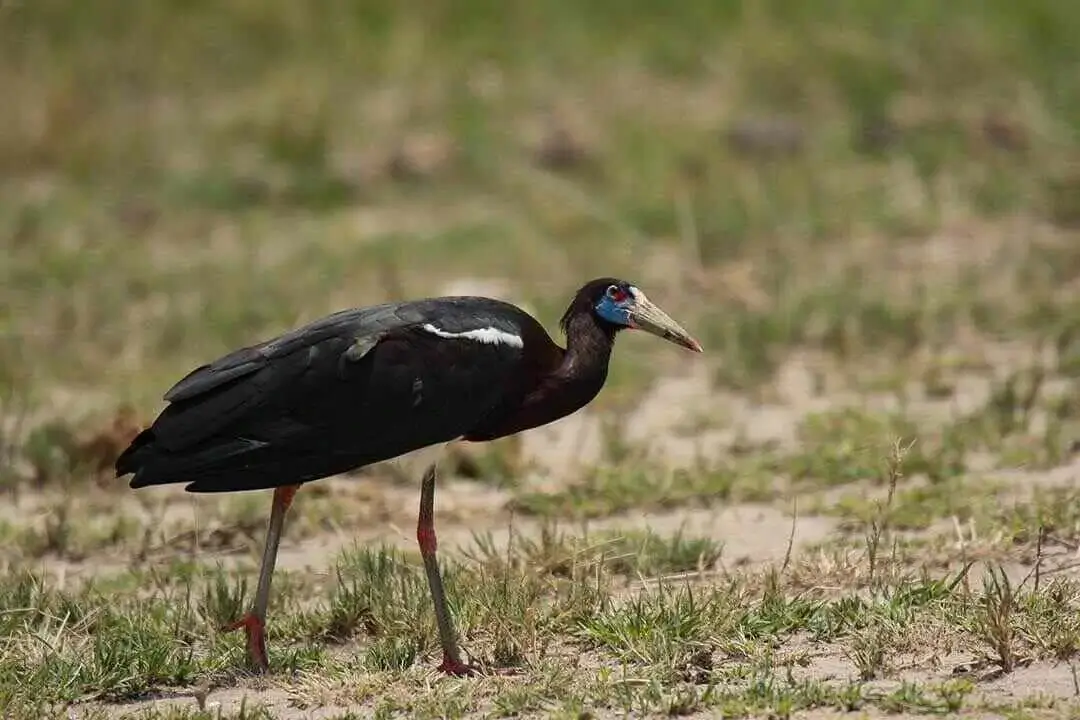Abdim's Stork
- COMMON NAME: Abdim's Stork
- SCIENTIFIC NAME: Ciconia abdimii
- DEIT: Locusts, caterpillars
Introduction
The Abdim's Stork (Ciconia abdimii), also known as the White-bellied Stork, is a medium-sized species of stork found in sub-Saharan Africa. This bird is notable for its migratory behavior, distinctive appearance, and its role in various African cultures.
Physical Characteristics
The Abdim's Stork is relatively small for a stork, standing around 73 cm (29 inches) tall with a wingspan of approximately 140 cm (55 inches). It is characterized by its striking plumage: glossy black feathers cover most of its body, while its belly and under parts are white.
The bird has a bare red facial skin, a blue patch in front of the eyes, and long, slender legs that are red during the breeding season and grayish otherwise. The bill is relatively short and grayish-green, distinguishing it from other stork species with longer, more pronounced bills.
Habitat and Distribution
Abdim's Stork primarily inhabits savannas, grasslands, and agricultural fields across sub-Saharan Africa. It is highly adaptable and often found near human settlements, where it forages in fields and pastures. The species is migratory, with populations moving northwards to breed during the wet season and returning to southern Africa during the dry season. Their migration patterns are closely linked to rainfall and the availability of food resources.
Behavior and Diet
Abdim's Stork is a social bird, often seen in flocks. It feeds on a wide variety of prey, including insects, small reptiles, amphibians, and small mammals. The bird is particularly known for following locust swarms and grass fires, taking advantage of the abundance of prey in these situations. It typically forages on the ground, using its bill to probe the soil and catch prey.
Breeding and Nesting
The breeding season for Abdim's Stork coincides with the wet season when food is plentiful. They build their nests in trees, cliffs, or buildings, often forming loose colonies. The nests are constructed from sticks and lined with grass and other soft materials. The female typically lays 2 to 4 eggs, which are incubated by both parents. After hatching, the chicks are cared for by both parents until they are ready to fledge.
Cultural Significance
In various African cultures, the Abdim's Stork is considered a symbol of good luck and prosperity. Its arrival with the rains is often seen as a positive omen, and in some regions, the bird is protected and revered. The species is named after the Turkish governor of Wadi Halfa, Bey El-Arnaut Abdim, who first described the bird to European scientists in the early 19th century.
Conservation Status
The Abdim's Stork is currently listed as Least Concern by the IUCN Red List due to its wide distribution and stable population. However, habitat destruction, pesticide use, and climate change pose potential threats to the species. Conservation efforts focus on preserving wetlands and grasslands, which are crucial for the bird's foraging and breeding needs.
Conclusion
In summary, the Abdim's Stork is a fascinating and important bird in the ecosystems of sub-Saharan Africa. Its adaptability, migratory behavior, and cultural significance make it a noteworthy subject of study and conservation.





All Birds

